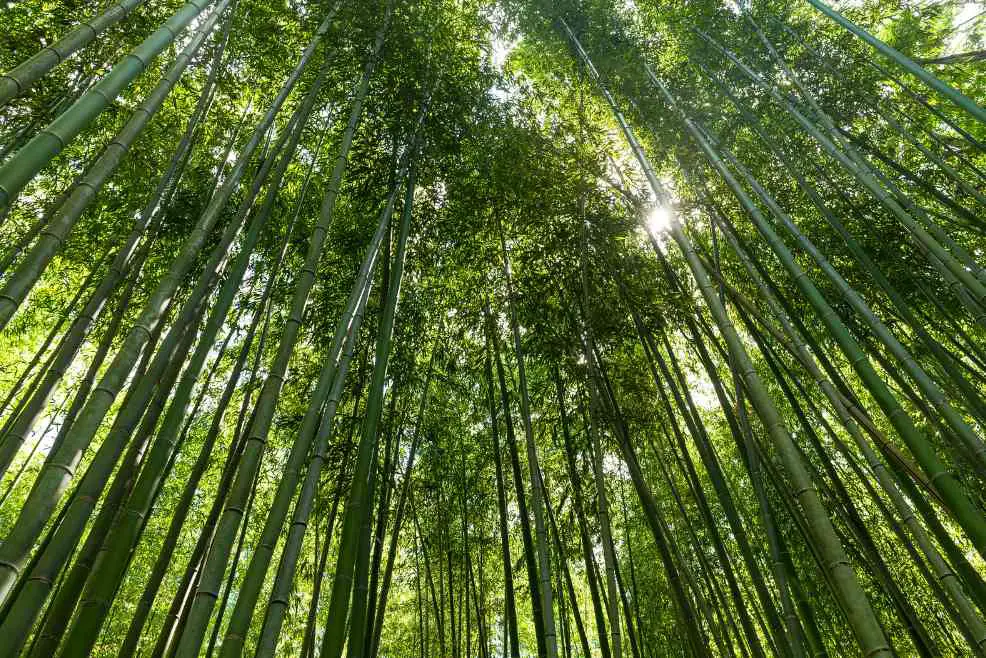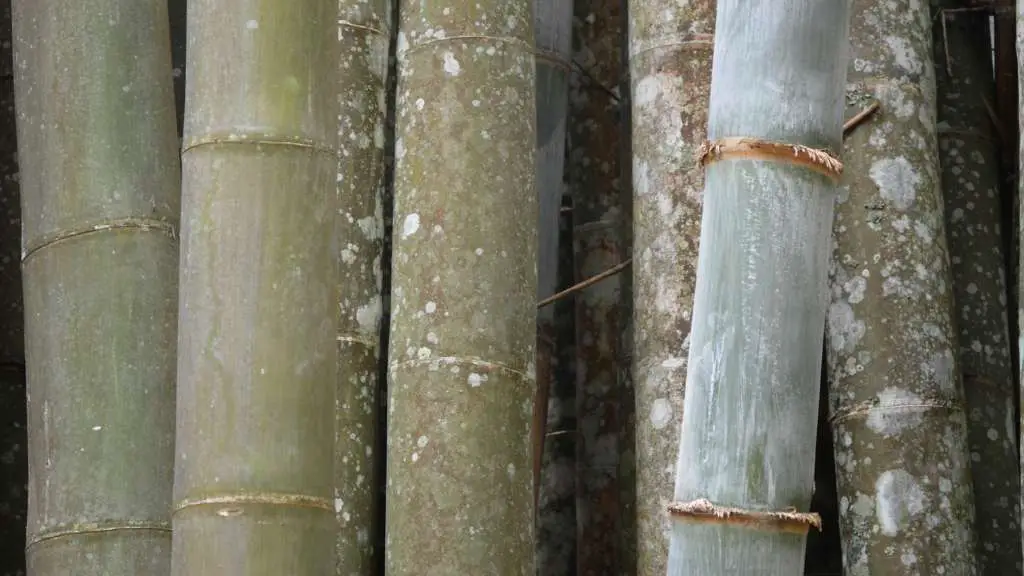The hardest part about farming bamboo on a commercial scale, in the US or Europe, is that it’s not a native plant. No one has been growing bamboo in these regions at a large scale for any significant amount of time. Not only that, but these parts of the world also lack a sizable industry for processing bamboo.
Native vs Non-native bamboo
When we hear about bamboo growing faster than any plant on earth without the need for pesticides and fertilizers, we naturally label it a miracle grass. And next thing you know, everyone with an acre or two of land wants to start farming bamboo.
True enough, bamboo’s properties of renewability and versatility make it an astonishing plant. But these superlative characteristics we read about are observed among select bamboo species growing in their native habitats, like Central China and Southeast Asia.
In some of those areas, the bamboo forests and groves have been around for longer than anyone can remember. No one ever had to think about which species to plant, how close to plant them, or what kind of fertilizer they would need. As native species, they simply thrive on neglect.
Dive deeper and take a look at our article about Where bamboo comes from.

People have been growing bamboo ornamentally in Europe and the United States for a century or two. And once again, the vigorous plant seems to flourish. In some cases, it appears to be indestructible, and not always in a good way. So now that bamboo has grown to something like an $80 billion-a-year global industry, it’s not surprising to see farmers trying to adapt the Asian grass to other habitats.
Pests, fungus and surprises
When farmers take an exotic, non-native, sometimes ornamental species, and try to turn it into a cash crop, interesting things can happen. They’ve heard that bamboo grows like a weed, requiring no additives or amendments. In some cases, especially in its place of origin, that’s true. Even on American soil, there are varieties of bamboo that can really run amok.
But growing like a weed and growing on a commercially competitive scale are different things altogether. Running bamboo runs one way in Yunnan, China. And it runs differently in Alabama or Portugal.
Nature has organized bamboo to grow a certain way in Indonesia, in China, and in Colombia. And farmers might think they can copy Nature in all her magnificence, but it’s never quite that easy. They might think they’re imitating the elegance of the natural world, but at the same time, these farmers are striving for optimal efficiency and satisfactory returns on their investments.
In their haste, their greed, or their naivete, Western bamboo farmers rush to get their bamboo into the ground and trust that the miraculous grass will get everything it needs from the air and the sun.
It turns out, however, that bamboo does need irrigation, it does require soil nutrients, and it is — especially in non-native settings — susceptible to insects, fungus, and other challenging issues.

A Florida farmer can look at an orange tree and know what it’s lacking. Or, if not, there’s a wealth of documented research he can turn to. But if he notices some of his bamboo clumps languishing, he’s at a complete loss as to how to diagnose it. Or, just as likely, he won’t even realize it’s languishing, because he hasn’t grown up around bamboo plants and seen enough of them in their full glory and splendor to have a reliable frame of reference.
Learn more in our in-depth article on Bamboo pests and diseases.
Species selection
One of the greatest hurdles is the simple matter of species selection. Yes, bamboo is amazing. But which, of the 1,500+ species, do you consider the most amazing? And will it grow in your climate or soil type?
There are temperate bamboos like Phyllostachys for climates that get snow and frost. Then there are tropical bamboos, like Latin American Guadua and Southeast Asian Dendrocalamus, that prefer to be near the equator and won’t tolerate the icy temps. And then you have a whole realm of sub-tropical bamboo, varieties like Bambusa that may or may not perform well with varying degrees of seasonal frost.
Then each species of bamboo has its own favorable characteristics, whether it’s great for poles, for shoots, for pulp, or all of the above. It can get pretty complicated pretty fast. And it could be several years before you know if you’ve planted an optimal species for your conditions and purposes.
Check out our article on Selecting the best bamboo for your garden.
The challenge of bamboo’s timeline
Yes, it’s true that bamboo culms can grow incredibly fast. But those first few years, while the plants are getting established, can feel slow and frustrating. It actually takes about 5 or 6 years for a plant to get well-established, and only then will it begin to produce those top-quality poles. But they shouldn’t be harvested right away. So realistically, you’re probably looking at about 8 years before you have some serious bamboo poles worth talking about.
In the meantime, it’s something of a guessing game to know what any given species — whether it’s from China, India, Vietnam, or Colombia — will do when you plant it in Florida, Georgia, Kentucky, or Oregon. It might look promising after the third year, but what does that tell you about year 8, 10, or 12?
There are nurseries that have been growing bamboo in Florida and Alabama for 10 or 20 years, and they can offer some insights. But no one in the States has been farming bamboo on a commercial scale for long enough to have the big picture of what a given species will do in a plantation setting, from seed to prime production to final flowering. In fact, no one can even really explain the mechanism that causes certain bamboos to flower gregariously or sporadically, in cycles that vary from 30 years to 130 years.
Take a look at our article on Bamboo flowering phenomena to learn more.
On the plus side, there are a number of ways to start monetizing a bamboo farm within the first few years, with offshoot products. The lateral branches and early, inferior culms are great for making into charcoal or biochar, which has a host of applications, as a soil amendment and for air and water purification.
The leaves of bamboo are very high in silica, particularly in certain species, and they make an excellent ingredient for tea and other nutraceutical products. Finally, fresh bamboo shoots are a very popular commodity in the US, and something farmers can begin offering after about the third year.
Bamboo farms and bamboo industry: Chicken and egg
One of the trickiest things about bamboo farming in America is the fact that the overwhelming majority of bamboo factories are operating in China. No one will ship their bamboo from America to China to have it processed.
Investors are reluctant to build processing facilities in the US when there is not sufficient acreage of bamboo to feed those factories. At the same time, farmers are hesitant to cover their acreage with bamboo when there aren’t large factories to buy their harvest.
However, given the interest in bamboo farming and production, it looks like planting bamboo is still a safe bet. After all, the farmers still have at least 6 or 8 years before they’ll be bringing a good harvest of bamboo to market. And that’s plenty of time for some paper mills and flooring factories to get set up.
In the meantime, there are other options for small-scale machinery that can turn bamboo into charcoal, pulp, or toothpicks. This type of equipment doesn’t require a multi-million dollar factory, but something more on the order of a $30 to $40K investment.

Conclusions
Farming is hard work, but it can also be incredibly rewarding. The important thing is to be realistic. Bamboo is fantastic, but it’s probably still something less than miraculous. And there are definitely some challenges to farming bamboo in places like the United States and Europe.
If you’re thinking of casting a sack of magic beans on your back 40, and then digging for bars of gold three months later, you’ll be in for a disappointment. Bamboo farming might not be the path for you. But if you’re willing to put in the time and the energy, and ride out the learning curve, you might someday wind up at the forefront of a booming bamboo industry, right here in the US.
Alternatively, you might wait for a handful of pioneers to work out some of the kinks and demonstrate a proven concept and timeline for commercial bamboo cultivation. Surely, there will also be opportunities in the field of bamboo processing and product development as well. The sky is the limit with bamboo, but like anything else worth pursuing, it takes diligence and planning.
Be sure to check out our articles on Bamboo farming in the US, Bamboo farming in Europe, and 6 Ways to make money growing bamboo.


























Great read like everything that comes out of your feather. Iraklis Kalamenios
Thanks for sharing!
Amazing information about the now “Green Gold” as me and my business colleague refers to bamboo. I appreciate your good works towards outlining some challenges of this incredible grass of our generation.